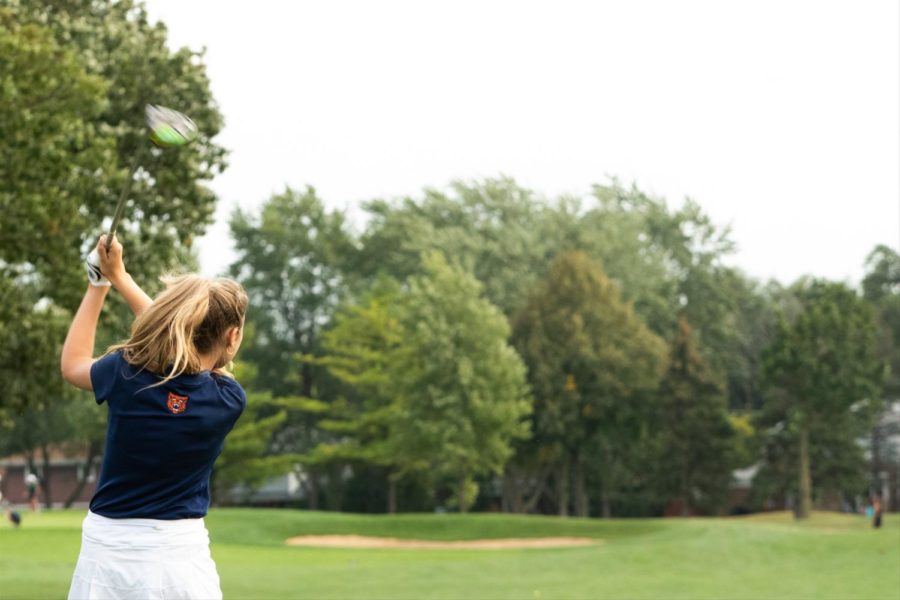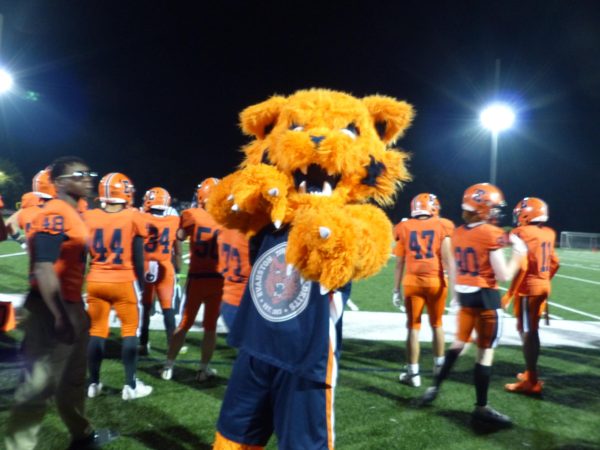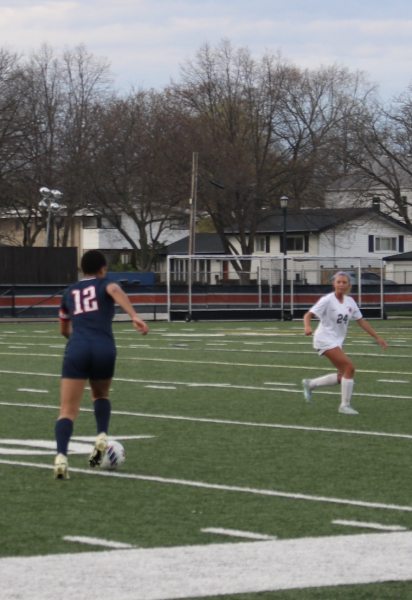“Gentlemen Only, Ladies Forbidden” history runs deep in Evanston
In the twentieth century, it wasn’t uncommon to hear the word “golf” referred to as being an acronym for the phrase “gentlemen only, ladies forbidden.” While use of this expression has declined as social consciousness of women’s issues has increased, the sport still maintains a high-level of gender-based exclusivity. ETHS girls golf is no stranger to this, and its participants have to deal with the stigma of being female in a male-dominated sport every time they step up to the tee.
“Golf is a ‘man’ sport, it always has been,” says junior golfer Amelie Koecher. “Even if I only do the bare minimum, it’s always considered better than expected. I’m definitely treated differently because I’m a girl playing golf.”
While the decline of the saying’s popularity has led to some girls golfers being unfamiliar with it, its connotations still hold.
“It doesn’t surprise me that [‘gentleman only, ladies forbidden’] is a motto in the golf world,” says senior golfer Eliana Veon. “I worked at a country club this summer, and it makes complete sense, because it was an all-white male sport for so long.”
As a matter of fact, there is still a sizable number of men’s-only golf clubs across the country, and the Augusta National Golf Club, yearly host of the prestigious Masters Tournament, was, up until 2012, one of them. They still refuse to host a women’s equivalent of the Masters, according to Women’s Golf Journal.
If given the choice between an environment that is hostile versus welcoming to one’s identity, people would always be inclined to choose the more welcoming one. Ultimately, this is a big reason why golf, and sports generally for that matter, tend to lack female participation. For girls golfers, who choose to persevere through their sport’s hostilities anyway, the lack of gender diversity often leaves them in uncomfortable situations.
“Whenever I make tee times by myself, I’m always with three [adult] men—always. Like, I’m never paired with another girl,” recounts Koecher. “I only have one female friend to play with that actually takes golf seriously.”
Generally, most sexism in sports stems from the notion that it is just not as exciting to watch girls and women play when you could be watching boys and men. Golf is no exception to this.
“People always think, ‘Oh, yeah, of course the boys team [is] more fun to watch,’” says Veon. “They’re like ‘They do better,’ but it’s just not true.”
This season, girls golf accumulated wins against Oak Park-River Forest, Regina, Niles West and Hersey, as well as a tie against Maine South in duals.
“We started off the season really strong,” says Veon. “Our varsity team was really good for about like the first three, four weeks—we were undefeated.”
By the time the postseason came around, the team was able to secure for themselves a fifth place finish at Conference and a sixth place finish at Regionals. They even had two players advance to Sectionals.
“At Regionals, we struggled a little bit because the course, [Northbrook’s Heritage Oaks Golf Club], was hard, but we had two players who got out and went to Sectionals and then they both did pretty well. At Sectionals, they didn’t move on to state, but they missed the cut by, like, five strokes,” tells Veon. “I think that’s a win for us.”
But despite all of this success, Veon feels that the achievements of the girls golf team this season, as well as just the achievements of female athletes at Evanston as a whole, have been overlooked by the school.
“It’s just like every single sport at this school, the boys get more hype unless the girls are state-ranked,” she says. “Like, look at hockey or basketball; our girls basketball team is better than our boys basketball team and, like, nobody really knows—the games aren’t hyped up like the boys are; the hockey games for the girls aren’t hyped up like the boys are.”
Perhaps the most blatant way this sexism manifests itself in ETHS golf is found in the fact that the boys and girls teams play their home matches at different courses.
“If you look at the courses we play, we play at Canal Shores—not the best course, especially for people who are really good,” Veon notes. “The boys play at Evanston Golf Club.”
Although undoubtedly a community staple, founded with the purpose of increasing access to the sport of golf, according to their website, Canal Shores isn’t close to being on the same level as Evanston Golf Club in terms of quality. It finds itself awkwardly sandwiched in between such landmarks as the Baha’i Temple, Evanston Hospital, the CTA, Chandler Newberger and, as evident in its name, the North Shore Channel, which it straddles. Evanston Golf Club, on the contrary, covers over 150 acres of land between Dempster and Main in Skokie, and has even been bestowed the nickname, “The Diamond of the North Shore.” Though both facilities indeed serve their respective purposes, it’s not really a contest which facility the girls golf team would find preferable.
Senior golfer Maddie Schrantz began a petition this past summer to change the practice location of the girls golf team from Canal Shores to a more difficult club. Schrantz believes increasing the difficulty of their practices will result in better overall play.
“Over the summer, I started looking into different courses and course options.I tried to get in contact with some of the Pro shop managers and course managers. But essentially what it came down to is our coach and the athletic director kind of stepping up and helping me do this” says Schrantz.
“We’ve been talking about changing courses for four years—since I was a freshman. They’ve been like, ‘It’s in the air,’” says Veon. “Maybe, next year, they’ll start having our home matches at a different course, but our home matches [this year] were still at Canal Shores. And I think the boys play there when they have absolutely nowhere else to go, which is just insanely unfair.”
If the Evanston girls and boys golf teams are supposed to be coequal, then they should both play their home matches at the same course; one program shouldn’t receive special treatment over the other. At the end of the day, the fact that this discrepancy has not yet been addressed by ETHS administrators just goes to show how the “gentleman only, ladies forbidden” trope still holds weight today. For the foreseeable future, girls and women golfers everywhere will continue to be met with resistance from the sport for no other reason than their gender. Until Evanston takes further steps to realize the ideals upon which Canal Shores was founded, echoes of golf’s “gentleman only, ladies forbidden” past will continue to ring true within our community.
As a senior, Schrantz wants future generations of players to continue taking steps to close the inequities of the sport. With regards to her and her teammates’ efforts in starting to petition this past year, Schrantz expresses, “I’m friends with a lot of girls on the team, the freshmen, sophomores, and juniors, so even when I’m gone, they’re still going to be there. [Ultimately,] I want to leave the program a little bit better than I found it.”
Your donation will support the student journalists of the Evanstonian. We are planning a big trip to the Journalism Educators Association conference in Philadelphia in November 2023, and any support will go towards making that trip a reality. Contributions will appear as a charge from SNOSite. Donations are NOT tax-deductible.






